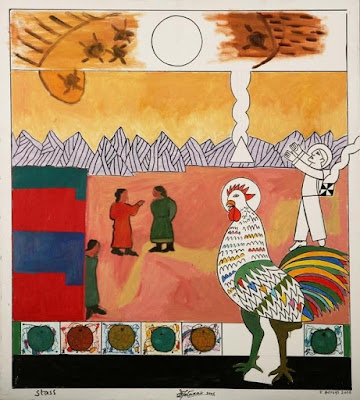Stass Paraskos (17 March 1933 – 4 March 2014) was an artist from Cyprus, although much of his life was spent teaching and working in England.
Paraskos was born in Anaphotia, a village near the city of Larnaca, Cyprus in 1933, the second of six sons of a shepherd farmer. He went to England in 1953 and became a cook in his brother's restaurant in the city of Leeds. This was a popular haunt of the local art students who encouraged Paraskos to enrol for classes at Leeds College of Art (later Leeds Metropolitan University). Despite not having the usual entry qualifications, Paraskos was spotted by the college's inspirational Head of Fine Art, Harry Thubron, who made certain Paraskos was accepted.There he became close friends with artists such as Dennis Creffield, Terry Frost and Wilhelmina Barns-Graham, with Frost and Barns-Graham persuading Paraskos to move to St Ives in Cornwall in 1959. In St Ives Paraskos shared a studio with Barns-Graham until he returned to Leeds in 1961 and began teaching at Leeds College of Art
Paraskos was born in Anaphotia, a village near the city of Larnaca, Cyprus in 1933, the second of six sons of a shepherd farmer. He went to England in 1953 and became a cook in his brother's restaurant in the city of Leeds. This was a popular haunt of the local art students who encouraged Paraskos to enrol for classes at Leeds College of Art (later Leeds Metropolitan University). Despite not having the usual entry qualifications, Paraskos was spotted by the college's inspirational Head of Fine Art, Harry Thubron, who made certain Paraskos was accepted.There he became close friends with artists such as Dennis Creffield, Terry Frost and Wilhelmina Barns-Graham, with Frost and Barns-Graham persuading Paraskos to move to St Ives in Cornwall in 1959. In St Ives Paraskos shared a studio with Barns-Graham until he returned to Leeds in 1961 and began teaching at Leeds College of Art
Paraskos's style of painting is figurative but non-naturalistic, and he uses bright colours to describe scenes which often seem rooted in his childhood in Cyprus. He is also influenced by the Byzantine church art of Cyprus, and modern masters, such as Paul Gauguin and Henri Matisse. Despite primarily being a painter, in 1992 he began work on an ambitious sculpture wall, in the village of Lempa, on the west coast of Cyprus. This wall is made of found and recycled everyday objects, and comprises a mixture of abstract and figurative forms, including a King Kong-sized gorilla, a pigmy elephant and a giant pair of welcoming hands. The wall is twenty metres long and up to four metres high.
In his book Aphrodite : The Mythology of Cyprus the late George Thomas, 1st Viscount Tonypandy, a frequent traveller to Cyprus commented: "...Greek mythology provides an eternal fascination... Stass Paraskos, one of Cyprus' most distinguished artists provides in this book an exciting recital of the influence Greek mythology has brought to bear on Greek Cypriot development..."Wikipedia








No comments:
Post a Comment